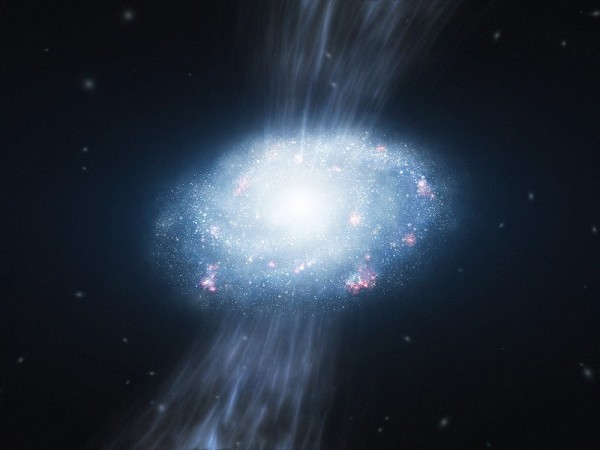Origins of the First Light in the Universe; Leaky Galaxy Provides Clues
| Ana Verayo | | Oct 11, 2014 02:20 AM EDT |
(Photo : Wikipedia) A galaxy found billions of light years away is emitting massive amounts of UV rays that provides clues how light was first emerged in the universe
Astronomers have discovered a galaxy located some 2.9 billion light years from Earth that emits incredibly massive amounts of ultraviolet radiation across the cosmos. The streams of intense UV rays are believed to resemble light formed during the birth of the universe.
This phenomenon is caused by leaking radiation seeping through holes found in a cold gas cover shrouding this galaxy. This event is similar to young galaxies forming before the Big Bang occurred some 14 billion years ago produced light across the universe.
Like Us on Facebook
This galaxy J0921+4509 is located in a region where stars are born. This process is believed to have ended darkness in the early stages of the universe after light was formed by the ionization and the breaking up of hydrogen atoms.
During the early formation period of the universe, the cooling of hydrogen atoms made its protons and electrons pair up to create neutral hydrogen gas. This process then absorbed all the radiation existing in the universe, which made it dark or invisible to astronomers.
To make light, the process will went on for billions of years so large amounts of UV radiation could ionize hydrogen gas. This event scatters electrons that make the universe appear visible with light and is now considered extremely pivotal in the foundations of the universe.
Regular galaxies only emit one percent UV radiation after these UV rays escape from its cloud cover of dust and neutral hydrogen. J0921+4509 emits a whopping 21 percent of UV rays into deep space.
According to study lead author Sanchayeeta Borthakur from Johns Hopkins University, Baltimore, this particular galaxy possess a "Swiss cheese" effect where its gaping holes are caused by the massive number of hot stars being formed, along with its extreme light and solar winds.
Many scientists think this 21 percent UV light emission is highly unusual as it debunks previous knowledge that galaxies formed in the early stages of the universe should only emit a fraction of UV radiation because it takse billions of years for hydrogen to ionize and produce light.
This study was published in the journal, Science.
Tagsleaky galaxy, light in the universe, hubble, origins of the universe, where did light come from, Origins of First Light in the Universe; Leaky Galaxy Provide Clues, Origins of First Light in the Universe; Leaky Galaxy Provides Clues
©2015 Chinatopix All rights reserved. Do not reproduce without permission
EDITOR'S PICKS
-

Did the Trump administration just announce plans for a trade war with ‘hostile’ China and Russia?
-

US Senate passes Taiwan travel bill slammed by China
-

As Yan Sihong’s family grieves, here are other Chinese students who went missing abroad. Some have never been found
-

Beijing blasts Western critics who ‘smear China’ with the term sharp power
-

China Envoy Seeks to Defuse Tensions With U.S. as a Trade War Brews
-

Singapore's Deputy PM Provides Bitcoin Vote of Confidence Amid China's Blanket Bans
-

China warns investors over risks in overseas virtual currency trading
-

Chinese government most trustworthy: survey
-

Kashima Antlers On Course For Back-To-Back Titles
MOST POPULAR
LATEST NEWS
Zhou Yongkang: China's Former Security Chief Sentenced to Life in Prison

China's former Chief of the Ministry of Public Security, Zhou Yongkang, has been given a life sentence after he was found guilty of abusing his office, bribery and deliberately ... Full Article
TRENDING STORY

China Pork Prices Expected to Stabilize As The Supplies Recover

Elephone P9000 Smartphone is now on Sale on Amazon India

There's a Big Chance Cliffhangers Won't Still Be Resolved When Grey's Anatomy Season 13 Returns

Supreme Court Ruled on Samsung vs Apple Dispute for Patent Infringement

Microsoft Surface Pro 5 Rumors and Release Date: What is the Latest?










